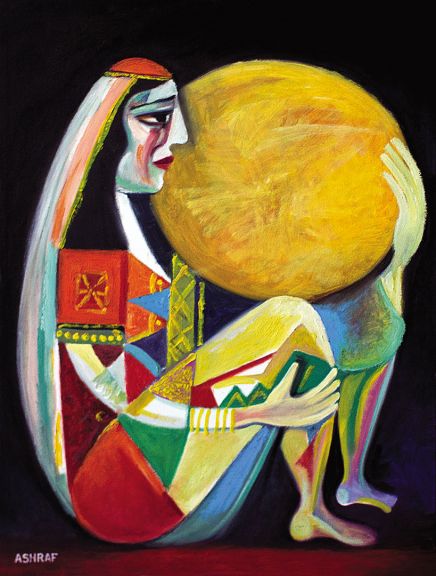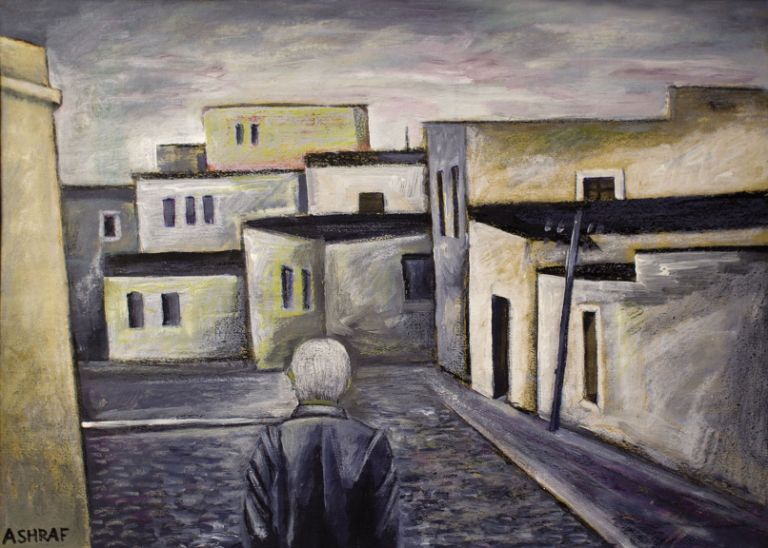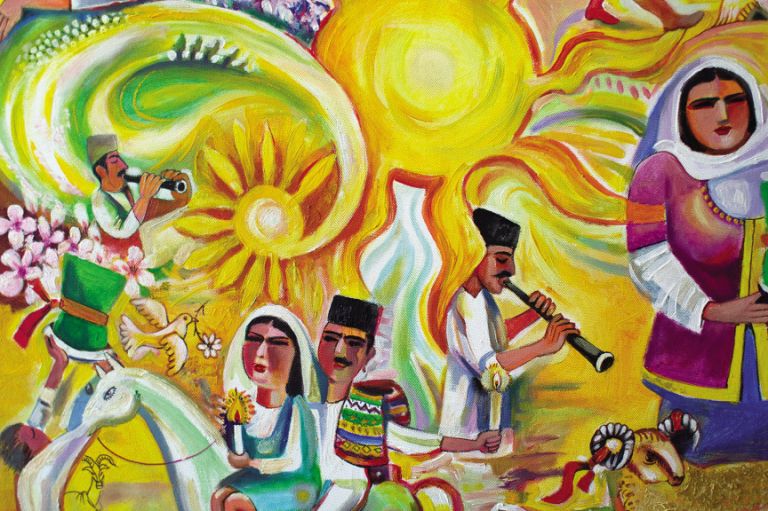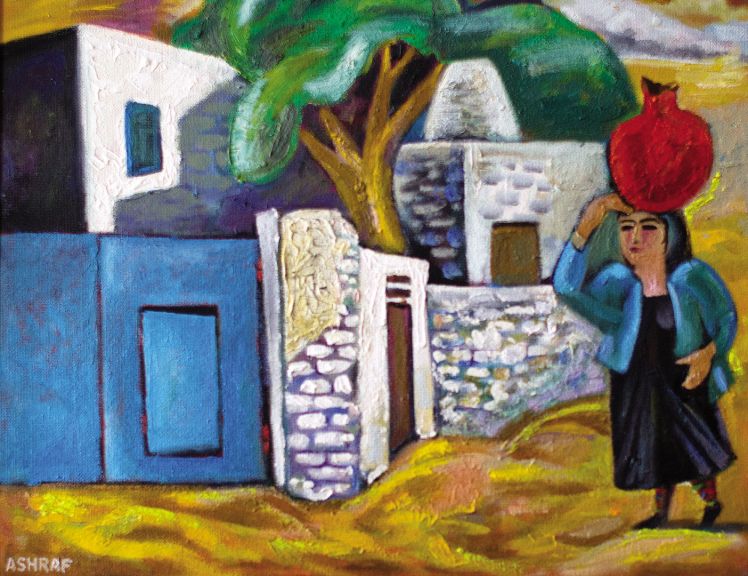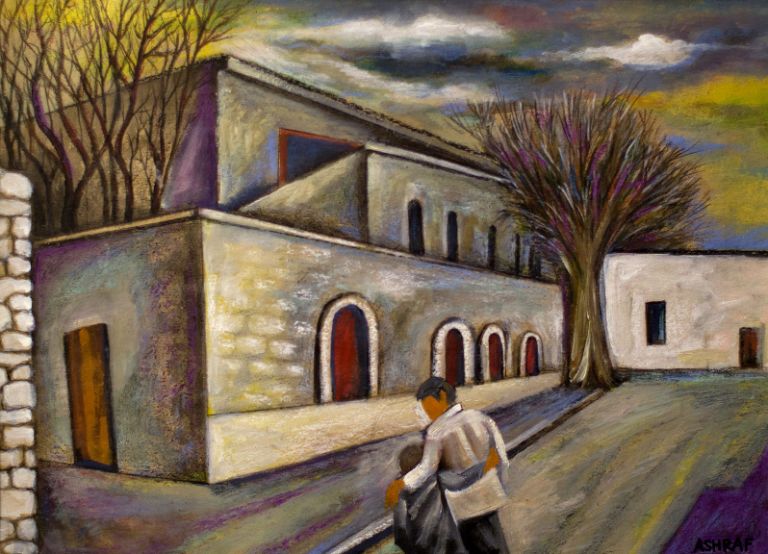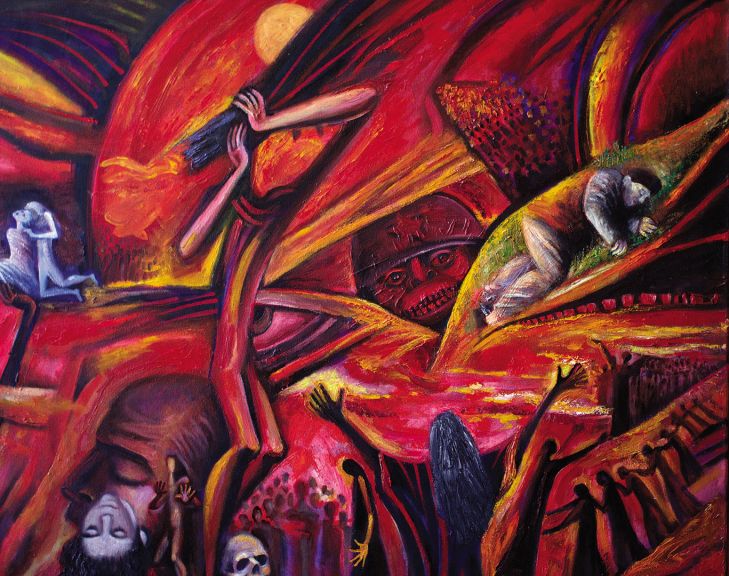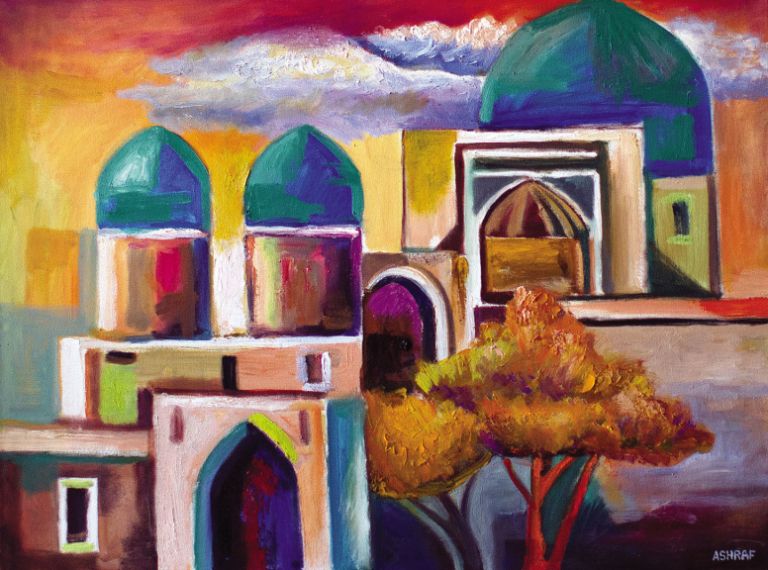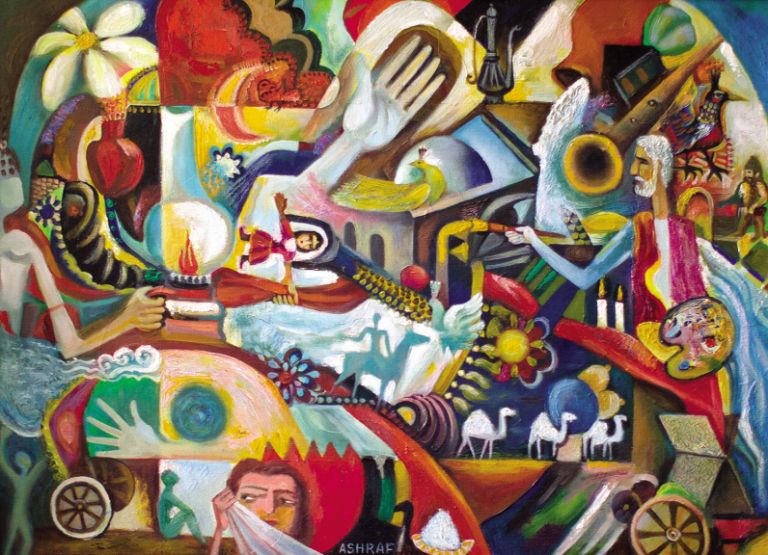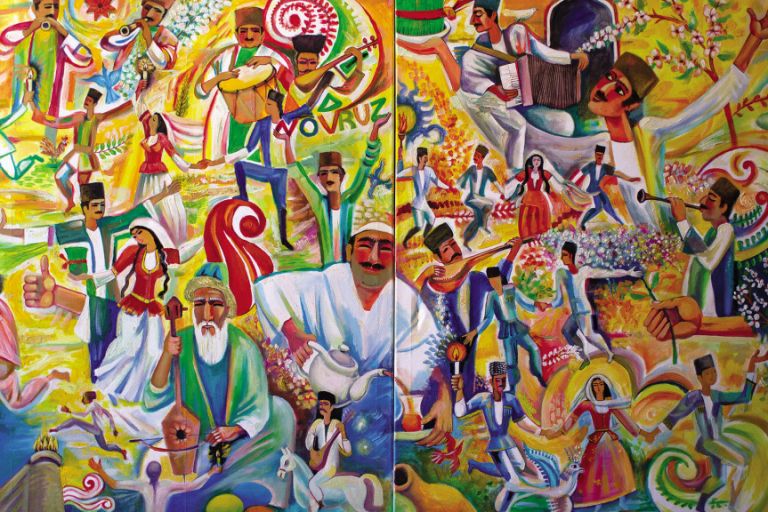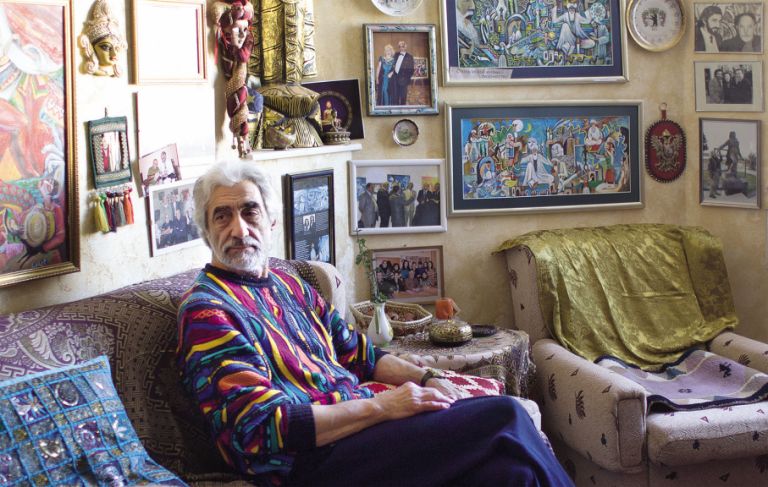Ashraf Heybat is an Azerbaijani Honoured Art Worker whose vibrant, surrealist paintings explore the traditions and culture of his native land. In February he turned 65 and an anniversary exhibition of his paintings was being prepared in Baku. In the meantime, writer Sabina Izzatli has been to meet him...
Ashraf Heybat was born on 18 February 1951 in Baku and grew up in Icherisheher (Baku’s Old City), where he lived until he was 12 years old. His mother and stepfather were both doctors but there was a great interest in art in his family, particularly from Ashraf’s neurosurgeon stepfather, Professor Surkhay Akhundov. When Ashraf turned 15, his stepfather started sending him to exhibitions in Moscow regularly. He grew up in an intellectual environment but despite the luxury lifestyle this afforded, his parents taught him to respect hard work.
First steps
When Ashraf was 12-13 years old he showed his paintings to Mikayil Abdullayev, a People’s Artist of the Azerbaijani SSR, when his father took him to the famous artist’s studio. Abdullayev evaluated the young artist’s work and advised him to continue his education at the Azim Azimzade Azerbaijan State Art School:
And that was that - at that moment I decided that I was going to be an artist. Then I graduated from the Azerbaijan State Art University.
In 1980 the Olympics took place in Moscow. During that period fellow Azerbaijani artist Tahir Salahov suggested that he go to Moscow and join the organisers’ team of artists. There Ashraf worked together with the famous Georgian painter Zurab Tsereteli.
You don’t become a painter in order to earn money
I painted a huge picture on the wall for which I received the Moscow Komsomol award. I’m pleased that I was able to meet Ilham Aliyev, current president of Azerbaijan, within the Moscow Olympics cultural programme. In 1981 he helped me to organise my first exhibition and that was the beginning of my art career.
The first exhibition was held at the Moscow Institute of International Relations. An article was published about the young artist and his exhibition, The Bright Colours of Azerbaijan, in Mezhdunarodnik, the institute’s newspaper. Then aged 30, Ashraf was motivated by the success of his first exhibition and the fact he was presented the institute’s distinguished award. Even now, having won countless others, Ashraf still considers this first award the most valued and cherished in his personal collection.
Theme of Azerbaijan
When Ashraf was 20 years old his neighbour, an Iraqi writer named Salim Adnan, once invited him over to meet two great artists - the acclaimed landscape painter Sattar Bahlulzade and Toghrul Narimanbeyov, who produced many vibrant works on the theme of Azerbaijan.
I was 20, Toghrul was 40 and Sattar was 60. This 20 year interval gap was quite magical - we shared the same spirit and aim to love our country and represent it in our work.
He considers Toghrul Narimanbeyov a genius and one of his best teachers. From the very first day of his professional career as an artist, Ashraf was deeply interested in the theme of Azerbaijan and his aim became to present his country to the world:
I was lucky that I could learn a great deal from Sattar Bahlulzade, People’s Artist of Azerbaijan. After a while people started to know me as Sattar’s best friend - when someone talked about me, someone else would clarify by asking: “which Ashraf? The Ashraf who’s Sattar’s close friend?”
Even when you drink tea, if the tea set is beautiful you enjoy it
As Ashraf became more deeply engaged in art, he strove to broaden his education as well. He studied at the Art Academy in Tbilisi, Georgia, and there he met the popular Georgian artist, Koka Ignatov:
Koka painted mainly about local topics and his country. His art inspired me a lot and had a big impact on my future career.
The art of love
If you were to ask me where does art begin, I would answer that art begins with love, he says, stressing the importance of finding inspiration when it comes to art.
Ashraf often recalls what his father would say: beauty makes life longer. In art beauty is about shapes, colours and harmony, he says:
What is beauty? Beauty is a nice dress, objects, furniture, dishes, a beautiful woman, nature, music, etc. One of my friends, the wonderful composer Elza Seyidjahan composed a piece of music called “Beauty.” Sometimes I like to listen to this song while working. You can create unbelievably great works around beauty. Even when you drink tea, if the tea set is beautiful you enjoy it.
Ashraf’s hobby is to collect antiques and other beautiful things: When I was a child we used to have antiques at home, I grew up among extraordinary, beautiful things, which is why I fell in love with everything that looks beautiful.
Birth has always been mysterious
He feels the need to be alone when he starts a new painting: This loneliness is like when a cat gives birth to a kitten and looks for somewhere to hide, trying especially hard to remain out of human sight. A work of art is also born like this. Birth has always been mysterious - it likes to stay hidden.
But this is only a short period, until he knows what to paint and how, then during the painting process he might listen to his favourite music. Music, he considers, is the closest art to God. When he works on patriotic paintings he likes to listen to Shamistan Alizamanli and Adalet Shukurov, singers who are friends of his as well.
However, his favourite melody is the national anthem of Azerbaijan: Even if I listen to it 10 times, I can still have tears in my eyes. I have our national anthem on my phone and I never get fed up of listening to it. While painting I prefer slow music, and from local composers my favourite is Eldar Mansurov. He is my friend too.
You can’t put borders around an artist, you shouldn’t put him into a frame
Like painters from the renaissance period, Ashraf loves to paint in different genres, which is why he is known as a universal painter. Over the years he has turned his hand to still life, landscapes, portraits, carpet sketches, wall paintings and book graphics. However, he doesn’t like to limit himself to any particular genre:
You can’t put borders around an artist, you shouldn’t put him in a frame. An artist has a free will and can apply his skills to different genres.
In Azerbaijan, Ashraf believes, there are many talented artists, but few who work across genres.
Azerbaijani artist
Ashraf lived in Moscow for 15 years and has spent the last 20 in Germany. Living abroad, far from his country, he often thinks about Azerbaijani ethnography, folklore, history and culture. He mentions that in Germany you can still come across many people who don’t know where Azerbaijan is, which is why, he believes, Azerbaijanis should strive to promote the country abroad, especially the artists:
Let it be just one per cent, but when this one per cent comes together we can present the country in a positive way in the world. When I have exhibitions abroad, first and foremost I inform others about my country. In front of my name there is always the title, “Azerbaijani artist,” this is very important. When my exhibition posters are prepared I ask for my name to be written in small letters with Azerbaijan in big letters. The Azerbaijani theme always dominates in my exhibitions.
Throughout his extensive portfolio 25 themes are reflected in his creative work, but the dominant theme is always Azerbaijan.
My areas of interest are mainly ethnography, spirituality, history and literature. I read a lot about these issues, I think an artist should be educated and read critically.
Art exists as well
During our conversation we talk about the major challenges for Azerbaijani artists. Ashraf believes it is the lack of attention for their work, which is why local artists teach to earn a living and struggle to find the time to develop themselves:
We need to promote our talented, well known artists abroad so that the world can see that there isn’t just oil and the Karabakh conflict in Azerbaijan, art exists as well.
Ashraf talks about the myths associated with foreign artists. Azerbaijani artists think that European artists can sell their work easily. But in reality it isn’t like that – purchases are decreasing there too. Also, European painters aren’t holding exhibitions to sell their work:
I live in the city of Koblenz in Germany. When I came here there were eight art galleries, but there are only three left and those galleries are mainly doing frames and restoration.
He believes an artist shouldn’t think about the commercial side of the work:
You don’t become a painter in order to earn money. The American writer Ernest Hemingway said that a painter firstly expresses himself by painting, secondly he paints for his audience and then he works for the masses.
Ashraf has never thought about making money through art and would almost prefer not to have an exhibition where his work is for sale. His aim was always to make a good name for himself in the art world.
Coming home
There is a saying in Azerbaijan: East or West, Home is best. Almost 35 years have passed since Ashraf lived in his hometown, Baku, but he says he plans to return for the final years of his life:
But now I don’t think about death, I think about life, he says, smiling. I’m planning to create a World Culture House in Azerbaijan. Maybe then I can come back to Azerbaijan to realise this dream.
For now, however, he feels he is more needed in Europe in order to keep promoting Azerbaijan abroad. He visits his native country twice a year, revisiting those narrow streets, the seaside and the places where he spent his childhood:
There is so much nostalgia! I have very close friends here in Baku, each time I come back I meet them. Among my favourite Azerbaijani writer friends are Anar, Natiq Rasulzade, Natella Osmanli, Rafael Huseynov, Chingiz Huseynov, Kamal Abdulla, Sabir Rustemxanli, my favourite composer Eldar Mansurov, favourite poets Fikret Qoja, Nusret Kesemenli, etc.
Of course he also has plenty of foreign connections too, such as the German singer Thomas Anders from the pop-duo Modern Talking and the Russian politician Yevgeni Primakov.
The Azerbaijani theme always dominates in my exhibitions
The colour and symbol of peace
Ashraf is also an International Ambassador of Peace and peace is also a recurring theme in his work. The colour of peace, he says, is blue, which also happens to be his favourite colour:
It is also the colour of mosque domes, the colour of the UN flag and the colour called Turkish blue (Goyturk) belonging to the Turkish tribes.
There isn’t just oil and the Karabakh conflict in Azerbaijan, art exists as well
He would paint the peace symbol as a free woman, without nationality. On the subject of peace, Ashraf recalls the tragic history of Azerbaijan. During the Karabakh War many innocent people died and we lost our land, he says. Ashraf’s painting Khojali, which relates to the tragedy during which 613 innocent civilians were killed in February 1992, is about the artist’s grief and sorrow:
I reflected the pain in my heart. I think every local artist should touch on this topic. My Khojali painting exhibited in Berlin and I’m about to present it in Baku in February for the first time.
Ashraf sometimes gives short masterclasses and advises young artists not to imitate others, to remain original as much as they can:
You can’t grow under the shade of a big tree.
Two wings of a bird
On how to correctly present the country abroad, Ashraf remembers what former German President Theodor Heuss once said: politics and culture are like the two wings of a bird.
Without culture, politics can’t fly to greater heights. Continuing the metaphor, he says that if one of the wings is the work of artists, then the second should be the country’s history:
In my exhibitions I always use national music, there is always a national flag and material about the realities of Karabakh.
You can’t grow under the shade of a big tree
Ashraf wants to celebrate his 65th birthday in front of his easel, with his favourite brushes and in a working mood. However he isn’t sure he will manage to - many friends will visit on the day. Following this he has no plans to slow down and wants to broaden his themes around Azerbaijan and the Turkish world.
I’m planning to work on a unique painting called “The Past, Present and Future of Azerbaijan.” It will be a great work but I’ll need a wall in order to get started.
About the author: Sabina Izzatli graduated from the Faculty of Journalism at Baku State University. She has contributed to the Institute for War and Peace Reporting and BBC Media Action, among others.